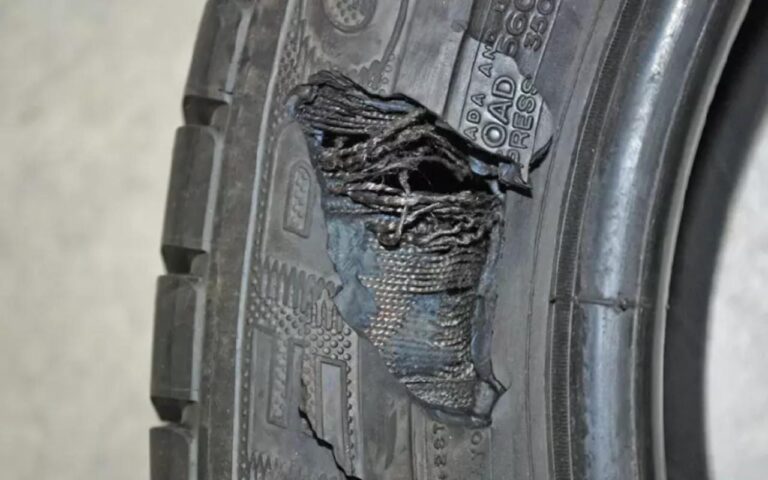You want to get your money’s worth, so as much as possible, you want your tires to last longer to save some bucks. Sometimes you see some cords showing on your tires and wonder if it will continue to serve. How long can you drive on tires with cords showing?
Users and tire experts say that tires with cords showing may still allow you to go for approximately 90 to 100 miles at a reduced speed. However, this is a serious indication of danger. Your tire can blow up anytime, so it is a risky move to continue driving with this tire.
The 90 to 100 miles estimate should allow you to drive your vehicle to the nearest tire shop and get a replacement. Replace your tires if they start to show cords because it is unsafe for you and your passengers.
Why Cords Show on Tires
I know you also wonder what causes cords to show on tires. The possible reasons why tire cables show on your tire include overuse, incorrect alignment, punctures/cuts, and improper inflation.
Let’s take a closer look at these reasons.
Tire Overuse
The apparent common reason for tire cable to show on tires is an overly worn-out tread. Your tire has an estimated life to tell you how long you can expect to use it safely.
As I pointed out, we sometimes want to get the total worth of our money and tend to ignore the risk. Occasionally, we know that the tire is only suitable for a 50,000 miles drive, yet we continue to use it even after hitting the mark.
I learned the hard way when my tire blew up in the middle of the highway because I used it for about eight long years, even when cords were already showing. The good thing was nothing serious happened other than getting stranded for over two hours.
There are also cases where a tire wears out prematurely. Many factors may cause your tires to wear out earlier than what the manufacturer has declared. Some of them are the condition of the roads you are driving, the alignment of your tires, and the manner you drive your vehicle.
So, the ideal thing to do is to check your tires from time to time to see the tread condition. Some manufacturers offer mileage warranties, so you may save some penny by taking advantage of the warranty if your claim is approved.
Alignment Problems
I am not sure how familiar you are with tire alignment. I will tell you anyway. It is the process of properly adjusting the vehicle suspension to ensure that the tires will achieve proper road contact.
How does it become a reason for cords to show on tires? Alignment issues will usually cause uneven tread wear. The typical wear that your tire will suffer due to poor alignment is on the camber and the toe.
Camber is the tilt of the tires that you see when you look at them from the front. On the other hand, the toe is the measurement that determines how much the front or rear wheels turn in or out. Here is a good article to read if you want to understand them further.
These areas of the tire typically wear out if your wheels are not correctly aligned. This scenario is not very hard to notice. So, if you see that your tire’s tread is not wearing out evenly, get some professional help and get your wheels re-aligned.
Punctures or Cuts
We cannot keep our tires away from road dangers like sharp or pointed objects all the time. I have experienced getting a wide cut on my tire due to scrap metal on the road.
It did not blow my tire, but it left severe damage exposing the metal cords on it. I took it to the shop, and the mechanic said that it was beyond repair.
Why is it a must to replace a severely damaged tire or that has an open cut? It is because water may get into the tire and cause corrosion internally, causing it to fail.
Improper Inflation
I am not the most responsible driver you could imagine. I don’t even look at my dashboard information like gas level or the tire pressure indicator. I hope you are not like me.
Not minding the amount of pressure on your tires can result in serious issues. You should be responsible enough to check if your tire’s air pressure.
How could improper inflation result in cords showing on your tires? Two possible scenarios would happen. Either your tires are underinflated or overinflated.
Frequent underinflation puts pressure on the edges of the tire’s sidewall resulting in fast wear out on this area. On the other hand, frequent overinflation causes your tires to become stiff, and it puts pressure on the center part of the tire, causing fast wear on that particular area.
In other words, it all boils down to uneven tread wear. If the tread is not wearing out evenly, there is a tendency that cords will start showing up on your tires.
Also, read our review on fuel-efficient tires from Bridgestone: Ecopia H/L 422 Plus
The Dangers of Driving on Tires with Cords Showing
I can’t stress out enough that driving your vehicle on tires with the steel cords showing is perilous. You must realize that the tire is on its critical level when cables start to show up. You must not ignore this issue as it can cause accidents and cost your life.
When a bald tire establishes its contact on the road surface, it generates more heat as there is not enough tread to allow air to pass through and avoid heat build-up. Also, the steel cable generates more heat than the rubber. When your tire builds so much heat, it can blow out anytime, putting you and your passengers in extreme danger.
You should also realize that speeding up will generate more heat than driving at a minimal speed. Thus, if you are an aggressive driver and have cords showing on your tires, don’t take the imminent risk.
When you first got your tires, you did not know that cords inside make them more durable until they started to show up. When these cords are exposed, the tire is no longer strong enough to handle driving pressures. These same cords can sometimes be the reason why you would get a flat tire.
Getting stranded on the road due to a flat tire is not a very lovely experience. We may have the money to get our car towed, but the level of pressure and hassle we experience is not compensable.
Moreover, when cords show on your tires, you cannot expect them to give you a reliable performance. You might quickly lose control of your vehicle because it will no longer give you the ideal traction and grip. Cornering and braking might be more challenging.
Driving with tires showing cords could mean inconvenience, and worse, death. Don’t be part of the statistics. The U.S. National Transport Administration Safety Board reports about 11,000 tire failure-related accidents from 2000 to 2015, and the death toll was 200.
If you want to get more information on how others think about driving on tires with exposed cords, you can check out this online thread or this resource.
Fixing a Tire with Cords Showing
Is it possible to repair tires with exposed steel cords? If it is possible, is it safe? How much does it cost? These are the questions to answer when you think about fixing a tire with cords showing.
A fix is possible. There is a process that we call retreading or recapping wherein the tire will be cured and remolded. The worn-out treads of the tire will be removed entirely and replaced.
Studies reveal that retreaded tires perform well and are safe for use. They deliver the same level of performance as the new tires. The question is, how much does it cost? The cost of doing this will make up your mind whether to do a tire retread or buy a new replacement.
The data I found online shows that retreading is not very affordable. I checked the quoted amounts that you shell out for a tire retread job, and I could say it costs almost the same, sometimes even more. Here is an article that provides information on average retreading costs.
Is it worth doing? Well, maybe it is, depending on your reason. If you want to help save the environment, retreading minimizes carbon footprint. For trucks that use big tires, this may be an ideal thing to do. But for standard SUVs, the best recommendation is to get your tire replaced with a new one.
When you see some cords showing on your tires, take action immediately. Either you fix it or get a replacement to ensure your safety. The latter is the safest and the quickest solution.
Summary
When you see cords showing on your tires, your tire will not last very long. It would approximately allow you to drive at most 100 miles to get to a local tire shop to get it replaced.
Yes, it is best to get your worn-out tire replaced. There could be an option to fix it, but the quickest, safest, and most ideal solution is a replacement. Money-wise, it doesn’t make that much of a difference.
Don’t fall into the trap of making the most out of your tire. Value your life over the worth of your money.

